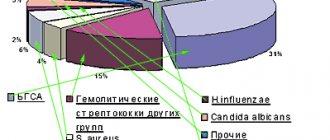Patient complaints are not so specific. Ingoda the patient comes to the otolaryngologist and cannot clearly formulate what is happening in his throat. Either it hurts or it doesn’t. Someone runs to the doctor and shouts: “I have a sore throat, I urgently need help.” Indeed, having seen certain redness in the throat, some patients evaluate this condition only as a sore throat.
Of course, pain and redness in the throat occur with various pathologies, and it is not always possible to distinguish a healthy throat from a diseased one by self-assessment.
What should a healthy throat look like?
Probably, most otolaryngologists will say: “I can only show the differences between a healthy and a sore throat in a photo or picture, because Nowadays, the impeccable condition of the oropharynx is a rarity.”
Most schoolchildren, despite their young age, have chronic signs of oropharyngeal diseases. Such pathologies include: tonsillitis, sore throat, pharyngitis, nasopharyngitis.
If inflammatory diseases of the throat are not treated, you can get not only local complications, but also become a victim of rheumatism, kidney and heart diseases. Moreover, an untreated acute infection in the throat often leads to surgical treatment, not to mention the fact that, for example, chronic pharyngitis remains a problem for life.
It should be noted that self-diagnosis is necessary. A patient with minimal knowledge of what a healthy throat should look like can already determine whether he has problems and whether he needs to see a doctor.
The textbooks on otolaryngology clearly highlight the signs of throat diseases, which can be used to determine whether everything is in order in the oropharynx. Among them are the following descriptions that define a healthy throat:
- the posterior wall of the pharynx has a smooth surface, there are no hypertrophied follicles, the network of vessels is not dilated, no other pathologies are observed,
- there is no visible swelling on the entire surface of the throat and nearby tissues,
- there is no hyperemia in all its manifestations: the throat has a color from pale pink to pinkish tones without spots. All parts of the throat practically merge into one color,
- tonsils are small in size, not swollen, and do not contain various inclusions or plaque. Small tubercles may be present; sharp transitions and elevations in the tonsil area are not observed.
Clinical picture
The acute form manifests itself:
- sore throat, which sometimes radiates to the ears if the lateral pharyngeal ridges become inflamed;
- a feeling of tickling and burning;
- dryness and discomfort in the throat;
- slight rise in temperature (usually no more than 38.0°C).
When palpating the lymph nodes of the neck, they are determined to be enlarged and painful. Examination of the pharynx reveals redness of its posterior wall and palatine arches, granularity is clearly visible (enlarged lymphoid foci of a brighter color than the surrounding mucosa). An important differential sign is the absence of inflammation in the tonsils with pharyngitis. This distinguishes it from a sore throat.
Chronic inflammatory lesions of the pharynx are easier than acute ones - fever and general deterioration in health are almost always absent. Usually the patient is concerned about:
- feeling of dryness and sore throat;
- dry cough with attacks;
- sensation of a lump or foreign body in the throat.
Due to the fact that mucous secretion accumulates on the back wall, a person constantly needs to swallow it. This causes significant discomfort.
The atrophic type of pharyngitis is accompanied by thinning and dryness of the mucous membrane, through which the vessels are visible. On its surface there may be crusts of dried mucous secretion.
The hypertrophic form is diagnosed by the presence of overgrown foci of lymphoid tissue, which are determined in the form of granules or strands. They are located behind the lateral pharyngeal ridges (these are the posterior arches of the palate). During an exacerbation, hyperplastic areas swell, increase in size, acquire a bright pink color, and foci of abscess formation may appear in them.
Healthy throat: differences from pathology
When examining a healthy throat, all the signs that we indicated above should be present, regardless of the patient’s age.
In most cases, a “beautiful throat” is rare. Some people have slight granularity, indicating pharyngitis, others have minor pathologies of the tonsils. And this is not to mention the obvious changes in the oropharynx.
When performing the diagnosis yourself, you should be alert to the following signs indicating a pathological process:
- mucus drips down the back of the throat. There may be several reasons for this condition: rhinitis, sinusitis, thinning of the pharyngeal mucosa, adenoiditis (more common in pediatric practice). Some patients refer to the mucus that drains as phlegm. It is not right. Sputum is secreted from the lower parts of the respiratory system and can appear in the mouth only when coughing (bronchitis, tuberculosis and other diseases),
- the appearance of redness of varying degrees of intensity, including individual spotting and granulation. The soft palate is often inflamed. The bright red walls of the pharynx stand out especially. This condition of the throat is accompanied by soreness, soreness, and itching. In principle, the presented picture indicates acute pharyngitis, starting with ARVI,
- The back wall of the throat is dotted with enlarged follicles, i.e. the pharynx has a loose surface. However, the throat does not have to be red. In most cases, this picture is observed in chronic forms of pharyngitis,
- uneven surface of the pharyngeal mucosa, all kinds of ulcers, blisters similar to herpetic rashes (possibly herpetic sore throat),
- inflamed and hyperemic tonsils, as if engorged with blood,
- the back wall of the pharynx seems thin, blood vessels appear on it, it is pale, as if covered with varnish. The presented description indicates atrophic pharyngitis,
Reasons for the development of the disease
In most cases, acute pharyngitis does not act as an independent pathology, but is only a manifestation of a general infectious process. Many infections (diphtheria, scarlet fever, measles, influenza) debut as an acute form of pharyngitis and are therefore not diagnosed in a timely manner.
In 70% of cases, acute inflammation of the pharynx is caused not by bacteria, but by viruses. Most often this is:
- influenza and parainfluenza viruses;
- rhinoviruses;
- adenoviruses;
- Epstein-Bar viruses;
- cytomegalovirus family;
- enteroviruses.
Only 30% of cases of acute pharyngitis are caused by bacterial flora:
- staphylococci;
- pneumococci;
- streptococci of groups A, C, G;
- Corynebacterium diphtheria;
- hemophilus influenzae;
- atypical pathogens are chlamydia and mycoplasma.
The latter are called atypical, because settle inside cells, and not on the surface of the mucosa, so the immune system cannot detect them. For this reason, such inflammatory processes take a long time, creating significant difficulties in carrying out etiotropic (acting on the cause) therapy.
In a small percentage of cases, pharyngitis is caused by fungal flora. As a rule, this is due to a general weakening of the immune system or local immunodeficiency (for example, in smokers). This is also facilitated by long-term use of antibacterial drugs.
If not treated correctly, acute pharyngitis can become chronic. Most often, pharyngitis caused by cytomegalovirus infection, Epstein-Barr virus, chlamydial and mycoplasma infection is chronic, since these microorganisms live inside cells and are not affected by local antibacterial and antiviral therapy. But inflammation caused by streptococci and staphylococci can also become chronic.
The development of chronic pharyngitis is a consequence of one of two processes:
- chronicity of acute inflammation of the pharynx due to poor immune defense;
- secondary infection of the pharynx from infectious foci located in the body (carious teeth, inflammation of the ENT organs, diseases of the digestive tract, etc.).
Factors that increase the likelihood of pharyngitis:
- hypothermia of the whole body or only the upper respiratory tract;
- alcohol abuse;
- eating sour, spicy, hot or cold foods;
- nasal breathing disorder.
Breathing through the nose becomes difficult in conditions such as:
- deviated nasal septum;
- nasal polyps;
- hypertrophy of the inferior turbinates;
- allergic rhinitis.
In these cases, a person has to breathe through his mouth, and this dries out the oral mucosa and reduces local immunity, because The production of immunoglobulin A decreases.
Atrophic pharyngitis is also provoked by other causative factors:
- lack of vitamins;
- anemia;
- functional heart failure;
- renal failure;
- diabetes;
- decreased thyroid function (hypothyroidism);
- menopausal syndrome.
Throat examination
Unfortunately, it is not always possible to examine the throats of loved ones objectively.
For example, while looking down the child’s throat, a mother suddenly sees something “suspicious” and in a panic drags the baby to the pediatrician.
Of course, many people lack medical knowledge, but parents who have two or more children in the family are more likely to gain experience.
And yet, you need to be able to determine whether your throat is healthy or sore, i.e. not to make a diagnosis, but to understand whether the oropharynx is normal or pathological.
To assess the condition of the throat, it is necessary to conduct an examination:
- bring the patient closer to daylight, it is better to find a place near a window, or sit him on a chair and take a flashlight with a bright light bulb. We ask the patient to open his mouth wider and press his tongue so that the entire lumen of the throat is visible. If this maneuver does not work for the patient, it is necessary to use a spatula or a teaspoon to press the tongue. Next, we illuminate the pharynx well and examine all parts of the throat,
- You need to press on the spatula carefully, because... Some patients experience a gag reflex, so the examination procedure must be performed quickly. Do not press the spatula on the root of the tongue; it is enough to press the tongue in its middle part,
- when examining the tonsils, when we need to assess whether there is tonsillitis or tonsillitis, it is enough to stick your tongue forward; there is no need to press it. Using a flashlight, we examine the tonsils for plugs and purulent contents,
- During the examination, the patient must breathe deeply and evenly, this makes it possible to lower the tongue to the lower palate.
Which teeth bite is not considered correct?
The presence of deviations from the norm is at least the basis for a dental diagnosis, based on the results of which a decision is made on the need for treatment. The best option is orthodontic correction in childhood, since the dentofacial apparatus, which is in the stage of formation, is more easily amenable to the targeted influence of a special machine and takes on the desired structure without surgical intervention. The most commonly diagnosed abnormal forms have certain signs that allow us to understand whether a person’s bite is correct or not, what is going wrong, and how this deviation can affect the further development of the jaw:
- Distal - diagnosed with excessive development of the upper jaw, noticeably protruding forward and distorting facial features.
- Mesial is a reverse pathological condition in which the mandibular row protrudes, almost completely covering the incisors and canines.
- Cross - characterized by the presence of free areas between the teeth, as well as a “scissor” intersection of elements in a random order.
- Deep - significant, more than 30%, overlap of the lower section.
- Open - contact during closure is observed only between individual chewing units, while in the incisal region there are pronounced gaps, creating the impression of a constantly slightly open mouth.
Any pathological manifestation requires timely medical intervention. Not all patients know what a correct bite in a person is and what it is needed for - but this indicator affects the quality of respiratory and speech function, ensures the conditions for normal food processing and the functioning of the gastrointestinal tract. By contacting Dentika dentistry, you can undergo a comprehensive diagnosis, receive recommendations from qualified specialists and, if necessary, resort to orthodontic correction services.
Diagnostics
Whether the patient has a throat disease or not, only a specialist can answer this question. The first step to identifying all problems with the throat is a visit to the otolaryngologist's office, where a differential diagnosis will be carried out. If in doubt, the doctor will prescribe a further examination, which includes:
- survey (collecting anamnesis). The doctor questions the patient in detail, determining the main complaints and the duration of the disease, if any. The doctor is interested in literally everything, even stressful situations that can cause, for example, aphonia,
- performing rhinoscopy (standard examination). Upon examination, pathological processes in the nasopharynx are detected,
- endoscopic rhinoscopy – therapeutic and diagnostic manipulation (allows for minimally invasive surgical interventions),
- X-ray examination of the maxillary sinus and other sinuses. Thanks to x-rays, acute and chronic foci of infection are determined,
- general blood and urine analysis . Particular attention is paid to indicators such as ESR and leukocyte count. Their increase indicates an inflammatory process. If band neutrophils are also elevated in the analysis, we are talking about an acute infection,
- bacterial culture from the nasopharynx . The results of the study allow us to determine which infection causes inflammation in the throat. Staphylococci take the lead in sowing; they inseminate the nasopharynx and lead to various diseases of the nose and throat. In second place are streptococci, and they are not inferior in insidiousness. For example, streptococcal tonsillitis often causes complications in the heart (myocarditis) and joints.
Complications
If left untreated, acute inflammation can develop into chronic pathologies, leading to constant relapses. What is the danger of diseases affecting the throat:
- What a healthy throat looks like - what a healthy person should look like
- tonsillitis quite often leads to complications from the heart, joints and excretory organs;
- against the background of prolonged tonsillitis, dermatoses and vasculitis develop;
- dysphonia of the hypotonic type leads to deterioration in the functioning of the vocal cords and muscle tissue of the larynx;
- jaw spasm;
- abscess in the pharynx;
- chronic bronchitis, sinusitis and otitis media;
- severe eye damage;
- hepatitis of various types.
When bacterial agents enter the blood, sepsis develops.
Treating a sore throat if necessary
Treatment for throat diseases depends on the diagnosis. A viral throat (usually pharyngitis) does not require antibacterial drugs.
It is enough to rinse with medicinal herbs and antiseptics.
Inhalations with alkaline solutions give good results.
The patient is also recommended tablet antiviral therapy.
Herpetic sore throat, like pharyngitis, is treated with antiviral drugs; antibiotics can only aggravate this disease. The treatment regimen includes antipyretics, antihistamines, vitamins and immunomodulators.
For sore throat and tonsillitis, antibacterial treatment cannot be avoided, and it must be carried out in a timely manner. Purulent plaque spreads very quickly, therefore, complications from other organs cannot be allowed. Typically, the treatment process begins with penicillins; if they are ineffective, they resort to macrolides or cephalosporins.
Fungal infections of the throat are often observed after long-term antibiotic therapy. To get rid of candidiasis, antimycotic and antiseptic agents are used. Irrigation, rinsing, dissolving tablets and lubricating with solutions are prescribed. It is possible to quickly cure a fungal infection, provided that all the specialist’s instructions are strictly followed.
Important! It is strictly forbidden to carry out independent antibacterial treatment. Unfortunately, many citizens attribute antibiotics to themselves without any justification, explaining their actions in order to prevent complications at all costs.
General rules for treatment
Self-medication is strictly prohibited. If parents discover a red throat in a child, it is necessary to contact a specialist to clarify the diagnosis and prescribe a course of treatment. READ ALSO: A child has a red throat: how to treat inflammation at home?
Medication approach
Depending on the disease, the doctor prescribes medications to relieve inflammation. Medicines, especially antibiotics, cannot be selected independently - many of them have serious side effects. The following agents are used in therapy:
- For bacterial infections of the pharynx and sore throat, the antibiotics Augmentin and Amoxicillin are used.
- The drugs Umkalor, Tonsilgon and Lymphomyosot have antimicrobial and antiviral properties (for more details, see the article: Tonsilgon drops: instructions for use for children under one year old). They are available in the form of drops, which is convenient for treating small children. The remedies fight the disease, eliminate unpleasant symptoms and help improve immunity.
- For herpes and other types of viral infections, interferons, Tamiflu, Remantadine, Lavomax, Acyclovir are prescribed.
- If the disease is caused by fungi, the specialist prescribes Fluconazole or Levorin (we recommend reading: instructions for use of Fluconazole for children).
- For redness of the throat caused by an allergic reaction, antihistamines (Xyzal, Cetrin, Ebastine, Zyrtec) are prescribed. It is necessary to completely exclude the baby’s contact with the irritant.
- If a nonproductive cough is added to the redness of the throat, drugs to thin and remove mucus - Prospan, Ambroxol, etc. - are included in the treatment regimen.
- To reduce body temperature and relieve pain, Nurofen and Paracetamol are used.
Local treatment for a sore throat
To relieve the symptoms of the disease, topical agents are often used:
- Sprays Tantum Verde, Ingalipt, Bioparox, Chlorophyllipt act as antiseptics (we recommend reading: Tantum Verde spray: analogues of the drug for children). The drug sprayed onto the mucous membrane reduces pain and softens the throat. Active components fight pathogenic flora.
- Tantum Verde and Septolete lollipops have a “cooling” effect and reduce pain. Excellent help with dry cough and sore throat. By sucking the lozenges and swallowing saliva, the child removes the mucus accumulated in the throat.
- Miramistin solution, as well as the preparations Tanin (1-2%) and Antiformin are antiseptics used for gargling. Regular procedures gradually clear the mucous membrane of plaque. The active substances in the solutions destroy pathogens and relieve inflammation.
- Silver Nitrate solution 0.25% or Lugol's - for periodic lubrication of the tonsils (we recommend reading: how to use Lugol's as a spray for children?). Used to relieve inflammation and reduce pain.
- A solution of salt and soda with the addition of a few drops of iodine or chamomile decoction reduces discomfort and acts as an antiseptic.
- Compress made of rye flour, honey and vegetable oil. Mix the mixture until it has the consistency of dough, heat it in a water bath and apply it to the sore throat for 20 minutes. The product relieves swelling, inflammation and pain.











